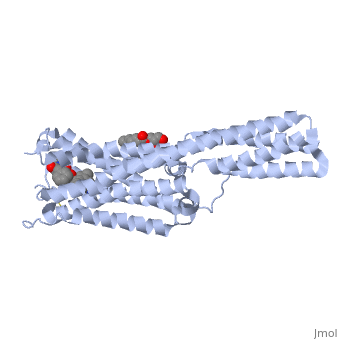Function
5-hydroxytryptamine (5-HT), Serotonin receptors are found on the membrane of neurons in the central nervous system and peripheral nervous system. These receptors allow for the body to respond to serotonin and regulate many biological pathways. Serotonin, also known as 5 hydroxytryptamine, is an endogenous neurotransmitter made from tryptophan and is largely found in the gastrointestinal tract. It is known to regulate mood, appetite, digestion, circadian rhythm, learning and internal temperature regulation. It is can be an inhibitory or excitatory neurotransmitter that is released into the synaptic space and can bind to receptors on the postsynaptic neuron or be taken back up into the presynaptic neuron via Serotonin re-uptake transporters.[1] 5-HT receptors are classified into 7 different subfamilies (5-HT1, 5-HT2, 5-HT3, etc.) by signaling mechanisms and homology of structure. All 5-HT receptors are known to have G-protein linked pathways except for the 5-HT3 receptor which acts as an ion channel. [2]
Structural highlights/Specific Function of 5-HT1B
The couples to G-protein alpha subunits Gi and Go. In the central nervous system, this receptor is an inhibitory presynaptic receptor that can alter the release of serotonin, as well as other neurotransmitters, from the presynaptic neuron. The structure of this receptor includes . of 5-HT1B is close to the ligand binding pocket suggesting some interaction with its ligand. , also called the orthosteric binding pocket, is characterized as a cavity formed from residues of the 3rd, 5th, 6th, and 7th alpha helices and the 2nd extracellular loop (ECL2). [2]
Structural highlights/Specific Function of 5-HT2B
The is important in utilizing serotonin signals to encourage proper development and continuing function of the cardiovascular system. Overexpression of 5-HT2B has been linked to congestive heart failure.[3] 5-HT2B utilizes the alpha Gq protein pathway which triggers intracellular cGMP production through activation of nictric-oxidase synthase (NOS).[4] This receptor is also known for being the target of the drug LSD, which is similar in structure to serotonin. [5] The structure of this receptor is much like that of 5-HT1B, however significant differences are seen in their binding pockets. The pocket of 5-HT1B is much broader than , due to a 3 Å shift of the top of helix V. Perhaps this difference highlights a variation in serotonin affinity between the two families. The similar characteristics of the 5-HT1B and 5-HT2B receptor families consist of 7 alpha helices and the N-terminus sticking out into extracellular space. [2]
Structural highlights/Specific Function of 5-HT2C
Serotonin 5-HT2C receptors are targets for treatment of depressive and anxious states[6]. 5-HT2C receptors may be involved in the effects of corticosterone-induced hyperphagia[7].
Structural highlights/Specific Function of 5-HT3
is a pentameric cation-selective ion channel and plays a role in neuronal excitation to release neurotransmitters from the postsynaptic neuron. Opening of the cation channel causes an influx of sodium and calcium through the receptor pore leading to a membrane depolarization. Five receptor subunits, A to E, have been found in humans but only subunits A and B have been found in rodents. When experimentally expressed in a host, the 5-HT3 receptor is comprised of either A or AB subunits which can result in a homopentameric receptor or a heteropentameric receptor respectively. The A and B subunits are found throughout the brain in areas such as the hippocampus and amygdala. 5-HT3 is a transmembrane channel that is stimulated to open state by the interaction of the receptor with serotonin in the extracellular space.[8] The binding site is comprised of six loops from two adjacent subunits in the extracellular N-terminal domain. Loops A, B and C form the principal subunit and contain the N128, W183 and Y234. Loops D, E and F form the complementary subunit of the binding site and contain the important side chains W90, Y143 and W195. The transmembrane region is comprised of multiple alpha helical structures and mediates ion flow and ion specificity.[9]
For more details see 5-ht3a receptor and Ion channels.
5HT-2B receptor agonists: Lysergic Acid Diethylamide (LSD)
Lysergic Acid Diethylamide, more commonly known as LSD, is a highly potent hallucinogen and is derived from ergotamine, an ergopeptine whose structural skeleton is contained in a diverse range of alkaloids. LSD acts as a non-selective 5-HT receptor agonist, meaning it can bind with equal affinity to two or more sub-types of receptors. LSD actively binds in the to both the 5-HT1B and 5HT-2B receptors, suggesting a similar chemical structure and function between the two receptor families. The docking is stabilized by all the same residues involved in normal binding in the orthosteric pocket. Hydrogen bonding between the amino group of the 5-membered ring of LSD and the T140 residue of the 5-HT2B receptor, as well as hydrogen bonding between D135 and the other ergoline amino group stabilize the LSD in a similar fashion that 5-HT would bind to the receptor. [2]
5-HT3 receptor antagonists
5-HT3 antagonists have been predominantly used as an antiemetic drug in relieving treating symptoms such as nausea and vomiting for a cancer patient receiving chemotherapy. Three high affinity antagonist often used are granisetron, tropisteron and ondansetron. The common structure shared among 5-HT3 antagonists contains an amine with an aromatic ring system and a carbonyl group. [9] Experimental homology modeling suggests that 5-HT3 antagonists have aromatic rings that form π-π interactions with the tyrosine, Y143 and tryptophan, W183, side chains of the 5-HT3 receptor. It is also theorized that the antagonist contain carbonyl groups which accept hydrogen bonds from serine, S227, side chain of the 5-HT3 receptor.[10] During the binding of granisteron to the 5-HT3 receptor, the aromatic rings sit within W183 and Y234 and an azabicyclic ring within W90 and F226 of the binding pocket.[9] Once a 5-HT3 antagonist has bound to a 5-HT3 receptor, serotonin binding is inhibited.[11]
For more details see 5-ht3a receptor.
3D structures of 5-hydroxytryptamine receptor
5-hydroxytryptamine receptor 3D structures

